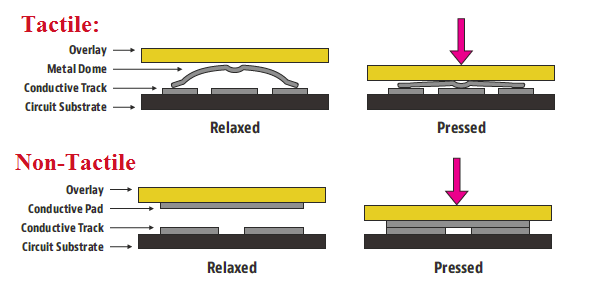Membrane Switches vs. Traditional Switches: What You Need to Know
Membrane Switches vs. Traditional Switches: What You Need to Know
Blog Article
Discover How Membrane Switches Function and Their Role in Modern Electronic Devices
Membrane Switches represent an advanced combination of modern technology and layout within the world of contemporary electronic devices, working as essential interfaces in various devices. Included several layers, these buttons use pressure-sensitive mechanisms to promote individual interaction. Their applications extend various sectors, from consumer electronic devices to medical tools, highlighting their adaptability and importance. Recognizing the complexities of Membrane switch capability and their wider implications in improving user experience welcomes more exploration right into their design, benefits, and the innovative advancements forming their future in technology.
What Are Membrane Switches?

Membrane switches are differentiated by their toughness and resistance to ecological aspects, such as dirt, wetness, and severe temperatures. They can be customized with various graphics, colors, and tactile feedback options, enhancing user experience while maintaining aesthetic appeal - membrane switches. Additionally, the consolidation of printed circuits allows for seamless integration into tools, boosting total performance.
The adaptability of Membrane switches appears in their capacity to sustain both complex and simple control features. They can integrate features such as LED indicators and touch-sensitive modern technology, accommodating certain individual requirements. As modern technology remains to develop, Membrane Switches remain important for enabling efficient and instinctive interface, thereby playing a crucial function in the development of modern-day electronic tools.
Parts of Membrane Buttons
Membrane buttons are composed of several essential components that interact to produce a reliable and practical interface. The main elements include the visuals overlay, adhesive layer, spacer layer, and conductive traces.
The visuals overlay acts as the individual interface, generally published on a flexible substratum such as polyester or polycarbonate. This layer not just offers visual appeal however additionally includes responsive responses, visual signs, and protective features. Beneath the graphic overlay lies the sticky layer, which safeguards the switch to the device and makes certain durability against ecological stresses.
The spacer layer is important for keeping the required space in between the visuals overlay and the circuit layer. This gap allows for the activation of the switch when stress is used. The conductive traces, generally made from silver or carbon, form the electrical pathways that complete the circuit when the switch is involved.
In addition, a support layer might be included for structural support and insulation. These elements work together flawlessly, ensuring that Membrane switches are both user-friendly and resilient, making them vital in numerous modern electronic applications.
How Membrane Switches Work
How do Membrane Switches feature successfully within electronic devices? Membrane Switches run on the principles of pressure-sensitive technology, utilizing a split building and construction that consists of graphic overlays, adhesive layers, and conductive components. When a customer uses pressure to the switch, the leading layer flaws, permitting the conductive elements below to make call and complete an electrical circuit. This activity activates the wanted feature within the device.
The style of Membrane switches is essential for their reliable operation (membrane switches). The layers are meticulously crafted to offer responsive comments, resilience, and resistance to ecological elements such as dampness and dust. The incorporation of domes-- little, raised locations within the button-- enhances responsive response, supplying users with a recognizable click feeling upon activation
In addition, Membrane buttons can be customized in terms of dimension, shape, and graphics, making them ideal for various applications. They are usually used in control panels, clinical devices, and consumer electronic devices due to their smooth layout and reliability. Generally, the efficient functioning of Membrane buttons is pivotal in improving customer interaction and guaranteeing smooth procedure read what he said in modern electronic great site tools.

Applications in Modern Instruments
Utilizing their distinct design and functionality, Membrane switches have ended up being important parts in a vast array of modern electronic tools. These functional user interfaces are employed in consumer electronics, industrial equipment, medical devices, and automotive controls, offering seamless user interaction.
In consumer electronic devices, Membrane buttons are generally located in devices like microwaves, cleaning makers, and various other family gadgets, where they allow user-friendly control with a smooth profile. Their inconspicuous layout promotes assimilation right into small devices, enhancing visual allure without jeopardizing performance.
In industrial applications, Membrane Switches act as control panels for equipment, supplying longevity and resistance to harsh settings. Their capability to endure moisture and impurities makes them excellent for usage in manufacturing and handling markets.
Medical devices additionally benefit from Membrane buttons, which are developed to be very easy to tidy and maintain, ensuring health in medical setups. They are commonly used in diagnostic equipment, individual monitoring systems, and mobile medical tools, where dependability is paramount.
Benefits of Membrane Buttons
One of the crucial benefits of Membrane switches is their adaptability, which allows them to be customized for a variety of applications throughout multiple markets. These switches can be created in various shapes and dimensions, fitting one-of-a-kind product needs while offering smooth integration into tools. Their thin account makes it possible for a compact and streamlined design, usually improving the visual appeal of electronic items.
An additional significant benefit is their durability - membrane switches. Membrane you could try this out buttons are typically resistant to dirt, dampness, and chemicals, making them perfect for extreme settings. This resilience prolongs their life-span contrasted to conventional mechanical switches, minimizing the demand for frequent replacements
Furthermore, Membrane Switches deal cost-effectiveness. The production procedure involves printing technologies that lessen manufacturing prices, specifically for large runs. This affordability, combined with low maintenance demands, makes them an appealing alternative for manufacturers.

Verdict
Finally, Membrane Switches stand for a substantial advancement in interface innovation within contemporary electronics. Their layered building, pressure-sensitive operation, and adaptability to various applications underscore their significance across multiple industries. The durability and environmental resistance of Membrane Switches additionally boost their charm, making them a favored option for producers seeking reputable and adjustable solutions. As the need for durable and intuitive interfaces proceeds to expand, the function of Membrane buttons fit customer experience will definitely broaden.
Membrane Switches represent an innovative integration of modern technology and style within the world of modern-day electronic devices, serving as crucial interfaces in numerous gadgets.In the realm of modern-day electronics, Membrane Switches serve as critical elements that facilitate individual interaction with gadgets. As technology continues to advance, Membrane Switches remain vital for enabling intuitive and reliable customer interfaces, thus playing a crucial role in the innovation of modern electronic tools.
How do Membrane Switches feature efficiently within digital tools? In general, the effective performance of Membrane switches is critical in boosting customer interaction and making sure smooth procedure in modern electronic tools.
Report this page